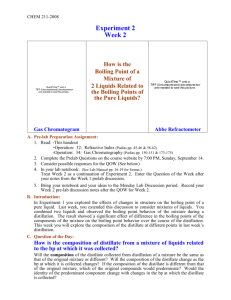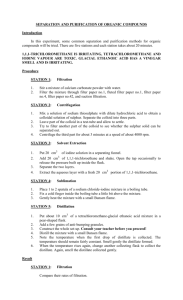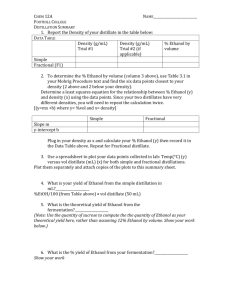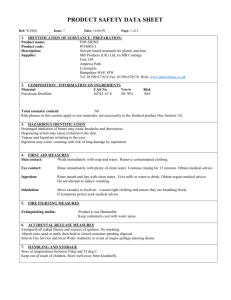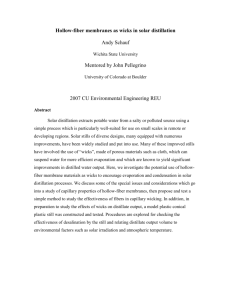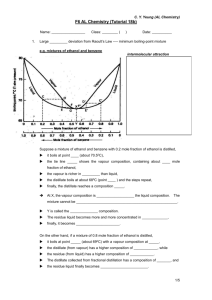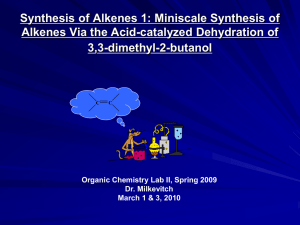Chem 3 - GEOCITIES.ws
advertisement
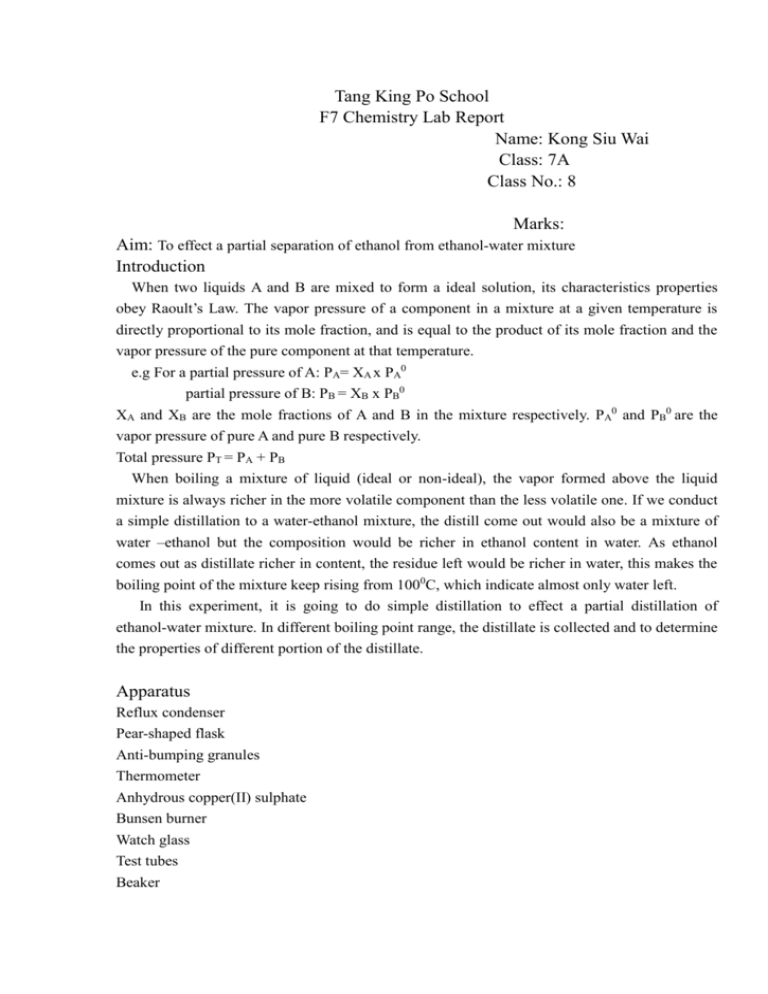
Tang King Po School F7 Chemistry Lab Report Name: Kong Siu Wai Class: 7A Class No.: 8 Marks: Aim: To effect a partial separation of ethanol from ethanol-water mixture Introduction When two liquids A and B are mixed to form a ideal solution, its characteristics properties obey Raoult’s Law. The vapor pressure of a component in a mixture at a given temperature is directly proportional to its mole fraction, and is equal to the product of its mole fraction and the vapor pressure of the pure component at that temperature. e.g For a partial pressure of A: PA= XA x PA0 partial pressure of B: PB = XB x PB0 XA and XB are the mole fractions of A and B in the mixture respectively. PA0 and PB0 are the vapor pressure of pure A and pure B respectively. Total pressure PT = PA + PB When boiling a mixture of liquid (ideal or non-ideal), the vapor formed above the liquid mixture is always richer in the more volatile component than the less volatile one. If we conduct a simple distillation to a water-ethanol mixture, the distill come out would also be a mixture of water –ethanol but the composition would be richer in ethanol content in water. As ethanol comes out as distillate richer in content, the residue left would be richer in water, this makes the boiling point of the mixture keep rising from 1000C, which indicate almost only water left. In this experiment, it is going to do simple distillation to effect a partial distillation of ethanol-water mixture. In different boiling point range, the distillate is collected and to determine the properties of different portion of the distillate. Apparatus Reflux condenser Pear-shaped flask Anti-bumping granules Thermometer Anhydrous copper(II) sulphate Bunsen burner Watch glass Test tubes Beaker Procedures 1. The quick-fit was setup to do the sample distillation. 2. The water-ethanol mixture was poured to the simple distillation set-up with anti-bumping stones added. 3. The water tap was opened into water condenser. 4. After the approval from the teacher, the Bunsen burner was allowed to light. 5. The reading from the thermometer of the distillate was recorded which come out first. 6. Five different test tubes were used to collect five different portions of the distillate, usually 2-50C per test tube until 1000C. 7. After collecting the five different distillate portion, several drops of the distillate was put from one sample to a watch glass. The distillate was light and the inflammability of the distillate was recorded. This step was repeated until the inflammability of all five samples had been recorded. 8. The volume of the distillate was kept to equal volume of five different test tubes. Then more or less the same amount of anhydrous copper(II) sulphate was out to the different test tubes. The color of the solid in test tube was recorded. Results Inflammability Distillate 1 highly flammable with blue flame CuSO4 No observation change(remains white color) 0 (81-84) C Distillate 2 flammable with little yellow color It turns very slightly blue 0 (84-88) C Distillate 3 slightly flammable with more yellow color It turns slightly blue 0 (88-92) C Distillate 4 very slightly flammable with yellow color It turns blue 0 (92-96) C Distillate 5 NOT flammable It turns very blue 0 (96-100) C Ease of flammability: Distillate 1 > Distillate 2 >Distillate 3 >Distillate 4 >Distillate 5 Content of water: Distillate 5 > Distillate 4 >Distillate 3 >Distillate 2 >Distillate 1 Answers to Questions: 1. As neither strength nor the nature of the intermolecular forces between water and ethanol molecules are quite different from that between the molecules. Hence, it is expected that water-ethanol mixture is a non-ideal solution. The strength of the intermolecular forces between water and ethanol molecules is weaker than that between like molecules (i.e CH3COOH---CH3COOH and H2O---H2O > CH3COOH----H2O), due to breaking of too many hydrogen bonds in water. Thus, the vapor pressure of the solution is greater than that of predicted by Raoult’s Law, molecules are easier to escape, concluding that it is a positive derivation. 2. To separate ethanol from water-ethanol mixture completely, fractional distillation is used. The principles underlying fractional distillation are illustrated in Figure 1. Imagine that a liquid of composition l1 (ethanol-water mixture)is heated until it begins to boil at a temperature b1(say, 810C). Then the vapor in equilibrium with the liquid has composition v1. If the vapor is condensed by meeting cooling surface of a distillation column, it condenses to form a liquid of composition l2. This liquid starts to trickle down the column towards the distillation flask. If it is heated, it begins boil at b2, to form a vapor of composition v2. If this vapor is condensed, it forms at a liquid of composition l3. By repeated vaporization and condensation, the composition of the vapor is made to follow the curve v1v2v3, becoming richer and richer in A (ethanol), the more volatile component. The liquid is becoming richer in the less volatile component, B (water) and it its composition follows the curve from l1 towards B. The longer column, the more vaporization followed by condensation steps will be achieved. Eventually, the closer to pure A (ethanol) and pure B (water) will the distillate and residue become. Figure 1 Figure 2 Conclusion Base on results obtained: the flammability of distillate decrease with the distillates’ boiling points. the water in content of mixture increases with the distillate’s boiling points, there are a couple of things to be concluded: At the beginning, the mixture is boiled, the distill come out is richer in content of ethanol than water. As ethanol comes out as distillate richer in content(i.e. the lower b.p the distillate have, the higher flammability is), the residue left is richer in water, so when the distillate with high boiling point, even 1000C they will turn anhydrous copper(II) sulphate to blue and not flammable, indicating almost only water left.

